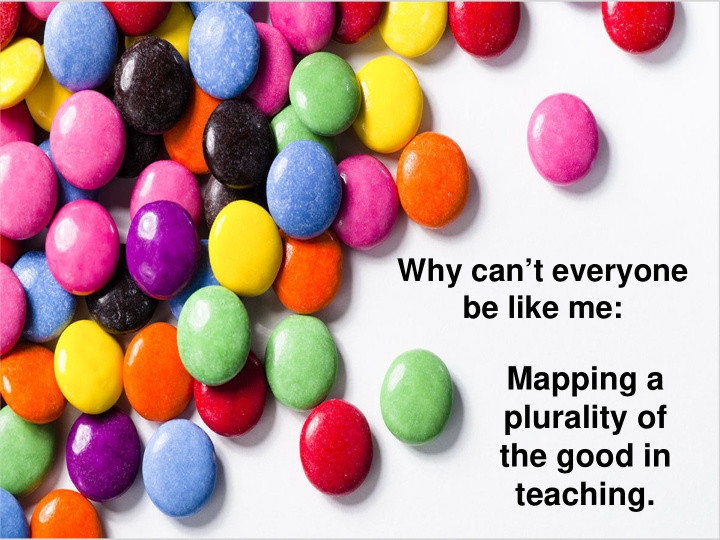



Why can’t everyone be like me: Mapping a plurality of the good in teaching.
Think about your most memorable teacher… … this person could be the best or the worst 2
Why are some teachers’ approaches different, but equally effective? What do they do that makes them effective?
List three words that describe who you are as a teacher … what qualities are important to you
1. Knowledgeable 2. Humorous 3. Engaging
How do you "show these” qualities? … (in other words, what do you 'intend' to do)
1. Teach new concepts/information 2. Make learning fun 3. You forgot you can check your email 1. Knowledgeable 2. Humorous 3. Engaging
What would we see in your teaching encounter? … what ‘actions’ show what’s important to you
1. What’s metacognition 2. “Outside of a dog a book is man’s best friend, inside of a dog it’s too dark to read” 3. Asking you to reflect on your own experiences 1. Knowledgeable 2. Humorous 3. Engaging
When hasn't this gone well? What did it look like? … a therapy session!
1. Information Overload 2. Crickets in the theatre 3. Losing the learner 1. Knowledgeable 2. Humorous 3. Engaging
Background and Acknowledgements Based on the work of Dan Pratt and John Collins • Several years in different countries China, Hong Kong, Singapore Canada, United States • Over 250 teachers (adult/higher education) What does teaching mean? What does learning mean? What difference does context make? • Teaching Perspectives Inventory (TPI) Over 300,000 people Over 100 countries Five languages
Teaching Perspectives Inventory Helps us understand ... • what we believe (beliefs) • what we intend (intentions) • how people see it (actions)
The Five Perspectives • Transmission (Content-oriented) • Apprenticeship (Context-oriented) • Developmental (Thinking-oriented) • Nurturing (Learner-oriented) • Social Reform (Social Norms-oriented)
Sample TPI Profile
The Transmission Perspective CONTENT LEARNERS X IDEALS Good performance = good teaching Z Y TEACHER CONTEXT
The Apprenticeship Perspective CONTENT LEARNERS We teach who we are, IDEALS as well as what we know. TEACHER CONTEXT
The Developmental Perspective CONTENT LEARNERS X Less (coverage) can yield more IDEALS (understanding). Y Z TEACHER CONTEXT
The Nurturing Perspective CONTENT LEARNERS X They may forget what you said, IDEALS but they will never forget how you made them feel. Y Z TEACHER CONTEXT
The Social Reform Perspective LEARNERS CONTENT X The goal of education is not just IDEALS to learn about the world but to change it. Y Z TEACHER CONTEXT
Health Sciences (N = 9327) Humanities/Social Studies (N = 9967) Education (N = 3312) Math (N = 1720) Foundational Sciences (N = 3761) How do you compare?
Using the Teaching Perspectives Inventory • Supporting Faculty Development • Reflecting on your own teaching • Developing a Teaching Philosophy Statement • Getting student feedback (email: your.name@ubc.ca) • Advancing research projects and scholarship
Take Home Message …
Recommend
More recommend